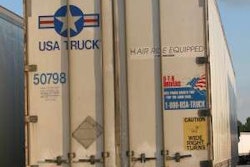 Air-Weigh's LoadMaxx Series of onboard scales includes an interface to a vehicle's J1708 and J1939 channels, a printer interface and tractor-trailer scale communications for drop and hook.
Air-Weigh's LoadMaxx Series of onboard scales includes an interface to a vehicle's J1708 and J1939 channels, a printer interface and tractor-trailer scale communications for drop and hook.
The basic features you need in a technology probably are obvious. You might need a device simply to capture a critical piece of information. The buying decision becomes more difficult when you learn about additional features that would be nice to have, but are they worth the extra cost?
Consider onboard scales. The only information you may need is the weight on the drive axles to know if a load is overweight. If so, a gauge that monitors the air pressure in the suspension systems may suffice. An experienced driver will know just by looking at the air pressure if a payload is legal, give or take a couple thousand pounds.
But for many fleets, a ballpark estimate is inadequate. Analog and digital scales provide more accurate and reliable methods to measure the on-ground weight. These technologies help ensure fleets maximize payload and eliminate the cost of using commercial scales that add at least $8 to the cost of each load, not counting the extra miles and fuel needed to reach one.
Weight for less
Analog onboard scales consist of a gauge connected to the air lines in a suspension system. The gauge is calibrated to show the weight of each axle group in pounds.
“Ours is a 10-minute install,” says Scott McCulloch, director of communications and business development for RightWeigh Load Scales. RightWeigh offers two types of gauges: the exterior mount 310-54 model, which comes in both dry and liquid-filled versions, and the interior mount 510-46 model. Each gauge is within 250 pounds of accuracy.
Fleets that use RightWeigh scales typically install one dash display for their drive axles and one exterior gauge for their trailer tandems, McCulloch says. If a fleet operates dedicated tractor-trailer sets, both tractor and trailer gauges can be installed in the dash, he says.
Besides being easier to install, analog gauges have a lower upfront cost.
Digital scales
As with analog devices, digital onboard scales calibrate the pressure in the air suspension system to an on-ground weight. The accuracy is comparable, but digital displays are easier to read and show the weights from the steer, drive and trailer axle groups in one location for all types of vehicle configurations.
Digital systems, which are more expensive, also can send an audible alert to the driver as the payload reaches its maximum weight. This feature lets drivers monitor weight while standing outside the cab. Some vendors offer mobile displays for added convenience.
TruckWeigh’s Smart Scale for air suspensions has three components: a sensor for each axle or axle group, a tee fitting for the vehicle’s air line, and a handheld receiver. The sensor transmits temperature and air pressure information to the handheld receiver using a low-powered radio signal. The receiver calculates a weight measurement for each axle group accurate to within 0.3 percent compared to a certified scale, the company says.
To save on hardware costs, TruckWeigh customers can use any existing handheld, PC or onboard computer with a Windows operating system as the receiver by installing a software component called FleetLink. “Technology seems to be going that way,” says Alex Dunphy, vice president of sales and marketing. “We are easily adaptable to that direction.”
Besides giving drivers more flexibility in monitoring weights, digital scales can record weights and integrate with printers and mobile communications devices. Air-Weigh’s LoadMaxx onboard scale transmits tractor and trailer weight information to the vehicle’s J1708 and J1939 communications channels, where it can be picked up by onboard computers and sent to the office. Weights can be reported alongside vehicle odometer and position.
Air-Weigh also offers a printer, which can be used to resolve weight disputes that delay billing. Drivers can print a weigh ticket for shippers and receivers to sign that contains the date and time of the weighing, along with axle weights, gross vehicle weight and net payload weight. “All metrics are available to you,” says Martin Ambros, president and chief executive officer. “You can’t get that with an analog gauge.”
The price advantage of analog and the expanded functionality of digital onboard scales create demand for both types of products.










